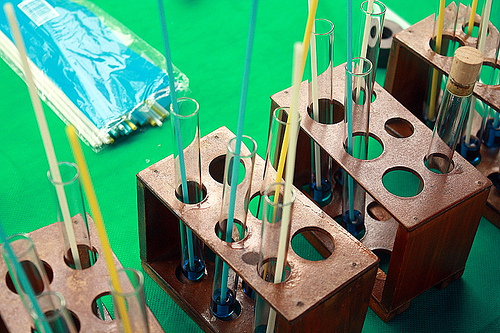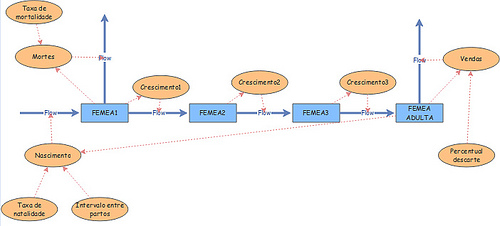
Photo by Posteriormente
I picked up a great tweet last week by @hugh_knowles, Principal Sustainability Advisor at forum for the future
We don’t have time to spend ages trying to get it right the first time. Need to experiment like mad, learn quickly and scale what works.
Learning In Agriculture
This is precisely what Esteban Tronfi of Aceite General Deheza in Argentina has undertaken with Agrotestigo. Esteban started from 3 key observations relative to change in food production systems in his geography:
- Reduction of yields which in turn requires…
- Adoption of a high number of innovations in…
- Shorter time frame compared to the previous innovation cycle in agriculture
Producers are facing a tremendous pressure and need to collaborate around the mounting environmental pressures from climate change and carefully select among a large array of new methods and technologies. Some will work better than others all depending on a variety of conditions. To help producers face these challenges Agrotestigo leverages crowdsolving techniques to map some of the pressures but also applications and results of possible responses to these pressures. The team used the Crowdmap service which provides a free SaaS version of Ushahidi as well as the tool which support the monitoring protocol familiar to citizen scientists. Agrotestigo interacts with farmers and agronomists in a structured manner to collect the information on the site. This application is closer to citizen science than 311-type reporting in that participants make a modest effort of measurement before submitting their data. The project is still in its infancy and aims at supporting collaboration among participants to discuss the results and decide what methods work best under what conditions. Agrotestigo is a great example of the citizen science approach can be used to validate our knowledge and assess the effectiveness of multiple approaches. Experiment like mad.
Shared Model Of Understanding
The starting point for bottom-up citizen sensing should be a shared model of understanding of system components relevant to the people involved. I am referring to a participatory systems thinking effort which gathers interested citizens around a model such as those found on InsightMaker

Source: Modelo de Rebanho Leiteiro Victor Barros Rispoli
This is a simple dairy herd model which captures livestock evolution at various ages from birth until sale in 3 stages. This type of system modeling was made popular by Jay W. Forrester and adopted by analysts across a wide range of disciplines including management, ecology or social sciences. Forrester’s students contributed a so-called system dynamics (SD) model for the Club of Rome publication The Limits to Growth. IBM recently collaborated with the city of Portland on a system dynamics model to devise development metrics for a 25-year plan for the city. A shared model of understanding is an essential basis for discussion. In my previous post precisely on this type of modeling, I mentioned the work of Krystyna Stave which experiments with Simulation Learning Environments (SLE) bringing SD models to life in order to complement education in environmental sciences. In a recent publication on SLE applied to the dynamics of accumulations, Stave et al. described the challenges and design considerations of shared models of understanding using SLEs. The challenges faced fell into 3 categories: scaffolding the domain knowledge and scientific inquiry, interface design and managing the cognitive load or limited capabilities of our memory for working out such models. The result of the study shows that students who use these modeling and simulation tools end up with a better understanding of the model components (stocks, flows) than those who didn’t. There are many ways to approach SD modeling and the importance here is not the initial accuracy of the model but rather there effort to bootstrap an initial shared model of understanding which can be re-visited by the group at a later point based on data gathering via sensing.
Hard And Soft Sensing
I frequently refer in the blog to hard sensing and soft sensing. The former refers to the use of a hardware sensor spewing data as a function of time. The latter refers to the submission by a human witness. Simple examples would be hard sensing NOx and soft sensing graffiti. The DIY movement combined with the Internet of Things is generating a number of interesting projects such as Air Quality Egg which proposes to measure air quality levels, in particular: nitrogen dioxide, carbon monoxide and dust. Another approach is to acquire commodity sensors which are pre-packaged such as Senspods. Given the cost of sensors – either effort (DIY) or money (commodity) – we are likely to see lending or pass-a-sensor schemes to cover large ecosystems. Soft sensing in turn is best demonstrated by 311 applications such as fixmystreet and numerous Ushahidi apps which address a wide range of civic questions from cultural heritage to disaster relief. While soft sensing is displayed on maps and large amounts of data points can easily be collated by zooming out, hard sensing time series data still requires more robust solutions to filter out significant outliers and step-changes in measurements.
The variables and events sensed by citizens involved are aligned with the shared model of understanding devised during the setup. The data is open and accessible to dataists which can then find new relationships and challenge the initial model. Soft sensing must also be open to the submission of solutions which address problems just as it is done in the Agrotestigo example. It is key for the community to go beyond the data collection and analysis but also collect information about what works and what doesn’t. Experiment like mad.
Feedback Loops At Work
Experiment like mad, learn quickly and scale what works. Systems science refers to loops or relationships between a system and its environment. Single-loop systems have the ability to sense, compare and act. If the system does not possess sufficient requisite variety, then certain changes in the environment will not be manageable. A second outer loop will actually be necessary to learn and adjust with regards to the goals set. This outer loop will recollect occurrences from the past data and trigger learning strategies from random change to more sophisticated approaches. Such outer loops to basic sensing implementations are essential to turn information into actions. In other words, the goals of hard sensing and soft sensing collection mechanisms are limited to detecting changes. The outer loop evaluates the changes and proposed solutions against the shared model of understanding. The group can then retain the same path, adapt the model and hopefully gain better insight.

The picture summarizes these ideas. Starting from an initial shared model of understanding, the community sets out to deploy a variety of sensing options which partially at least cover the model. The sensing is also extended to solution spotting which can then later be discussed in forums within the group. The shared model of understanding will be revisited and refined. It can be checked periodically for education purposes and data gathered is available for research purposes. Bottom-up approaches involving citizens actively in citizen science style will provide us with more transparency on a continuous basis as a complement to professional reports generated by experts. Coherence with national and supranational treaties and conventions will play here an important role. Clamping issues based on fresh data, from the bottom and from the top, could be a way to learn quickly and scale what works. It also represents in my eyes a missing part of governance mechanism for a more interlocked world where domino-effects are ever more likely to happen…
 This material is licensed under CC BY 4.0
This material is licensed under CC BY 4.0
